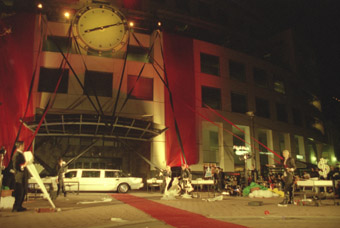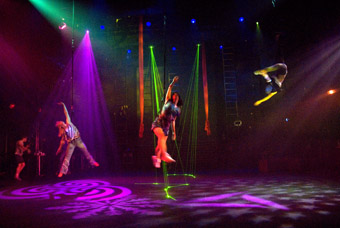where to now?
gavin findlay: canberra performance, part 2

Mini Epic (1999), Odd Productions, Garema Place, Canberra in front of the Department of Employment,
photo ’pling
Mini Epic (1999), Odd Productions, Garema Place, Canberra in front of the Department of Employment,
IN REALTIME 93 (HERE BE DRAGONS), WE TOOK A BRIEF TOUR OF CANBERRA’S ASTONISHING CREATIVE COMMUNITY IN THE MID 1990S AND TRACED ITS RISE. IN THIS ARTICLE, I WANT TO EXAMINE WHAT LED TO ITS DISPERSAL, WHERE EVERYONE WENT AND WHAT’S HAPPENING NOW.
In RT93 I also postulated that the loss of such artistic power makes it important to examine what led to such a flourishing and posed a series of questions that I will endeavour to answer here. The answers can’t be completely objective: I was too involved in it for that, but sufficient time has elapsed to try to make sense of what happened and draw out some lessons that could be valuable in rebuilding a coherent artistic community in Canberra capable of producing performing arts of significance.
The conditions for that community were founded in the educational and artistic revolution arising from Labor Prime Minister Gough Whitlam’s reforms of the early 1970s. The investment in education infrastructure and the opening up of curricula allowed the creative arts to flourish in the education system and suggested that any young person could consider the arts a valid career option. The creation of the Australia Council in the same era freed the profession from the patronage system that had until then kept the arts in Australia as a vocation that meant grinding poverty unless you were favoured by the wealthy establishment.
A generation of teacher/performers emerged who had access to generous project funding and infrastructure in Canberra. The creation of the Gorman House Arts Centre in 1981 provided Red House Theatre, Jigsaw Theatre-In-Education, Human Veins Dance Company and Canberra Youth Theatre a place to work, share ideas and to perform. As noted in my first article, many talented artists came to Canberra to work with these companies, bringing their families and settling here. Young people in Canberra with an interest in the arts had both an excellent training ground and eventually several major theatre and dance companies (Meryl Tankard, Kailash, Skylark and Splinters) that offered the prospect for continuing their artistic development in Canberra after school and university.
The critical mass that Splinters achieved, according to co-founder Patrick Troy, was based on two factors that drew on the surge of young artists this community produced: firstly, anyone could participate—we estimated that by 1994 some 1,000 people had participated in Splinters’ activities. Secondly, the company’s method was one of constant training and acquisition of new skills, leading to the rapid maturation of young artists and an unassailable confidence.
But by 1998 all four major companies had gone. The reasons for their dispersal are varied, but a common element was probably that they had become too large in scope to continue as they were in a small provincial city. Splinters in particular was used as a springboard by many who eventually headed to the big smoke with their own companies: first, and most successfully, Snuff Puppets (RT50), taking with them Simon Terrill, who has built on Splinters’ crowd theory work (RT87); art-rock band Prik Harness and later Mikelangelo and the Black Sea Gentlemen; machine artists Triclops International; Temple State’s event installations; and ODD Productions, which carried on the site specific performance practice. Remaining in Canberra was CIA, the vehicle for Splinters co-founder David Branson until his tragic death in 2001 (RT47).
Splinters, in the end, was also suffocated by external factors. The election of the Howard Government in 1996 meant that living on the dole was no longer viable for artists, and the imperatives of economic rationalism and the paranoia of the parliamentary budget estimates process meant that politicians demanded every penny given to the arts be scrutinised. Suddenly administrators were required for every artistic endeavour and arts bureaucrats became VIPs. The insurance crisis of 1997 provided perhaps the final nail in the coffin. Splinters performed (literally) dangerous work with pyrotechnics which we never dared let the local insurance company know about: out of interest I once sent an unexpurgated description of our work and program to Lloyds of London and was given a quote of US$20,000 to cover public liability.
As I argued in a review of the 2000 Festival of Contemporary Arts (RT46), Canberra’s cultural planners need to be brought to account for what happened. The stark facts are that Canberra has had, and gave up, two noteworthy performing arts festivals and since 1998 has had no full-time professional performing arts company of any sort. The ‘key’ funded arts organisations now mostly deliver infrastructure, services or training. In the absence of full-time jobs, theatre and dance artists have no choice but to leave town. As a direct result, any young performer with serious talent also has no choice but to leave Canberra after finishing school if they wish to pursue a career, and will probably never return to live here.
Canberra has always had a strong DIY aesthetic, and supporting pro-am arts is valid. But the city needs to properly acknowledge what it once had and seriously debate whether it wants it again and also how to achieve it. The chances seem slim. Recently, the interventionist Arts Minister, who is also the Chief Minister, agreed to the neutering of the vibrant small Fringe Festival that had grown around the Multicultural Festival by unilaterally transferring control of its funding to the National Folk Festival.

The House That Jack Built, Janine Ayres Areial Dance, Street Theatre
photo ’pling
The House That Jack Built, Janine Ayres Areial Dance, Street Theatre
The once mighty professional dance community in Canberra took a controversial left turn in 1996 when it abandoned the idea of a professional troupe to create The Australian Choreographic Centre. It was a bold experiment but ultimately failed to win the hearts of the public and was recently killed off and its reduced funding redirected to its innovative youth dance offspring, Quantum Leap. Grand dame Elizabeth Cameron Dalman in her bushland Mirramu studio aside, aerial specialist Janine Ayres is one of few left trying to keep and build a company. Her recent production The House That Jack Built (Street Theatre, October 2009) was refreshing and vibrant, with the young dancers throwing themselves into the work with gusto. Ayres should be applauded for having the guts to interpret the uncomfortable relationship between professional and experimental dance and the tribalistic dance of the nightclub world.
The prospects for theatre are no better. While pro-am companies such as Women on a Shoestring made excellent work over the years and The Street is now well resourced enough to support a few local productions, nowhere is there the cohesion offered by a dedicated stand-alone theatre company. Energetic RADA graduate Ian Sinclair, a Canberra native returned, tried in vain for several years to get funding to maintain his small ensemble Elbow Theatre. Eventually he gave up in despair and left town, along with actor Ken Spiteri and writer Mary Rachel Brown, who were beginning to establish national reputations. Gorman House Arts Centre is a shadow of its former self.
While no dance or theatre is taught at tertiary level, the presence of the ANU Centre for Photography and Media Arts ensures a thriving if small sound art scene, strongly supported by artist-run gallery/café The Front. It is a precious little gem, also home to a thriving burlesque movement led by Min Mae. Her Tableau Vivants project—a fusion of burlesque with the contemplative view of nude painting—has evoked the strongest reactions to any art work in Canberra in recent years.
Performance poetry is also showing signs of renewed life. In the 90s, Aktion Surreal took spoken word and performance combined with music into bars and galleries, evolving into publishing collective Abreaktion, while David Branson and poet Hal Judge convened the legendary cRaSh CaBaReT. Judge and Anne-Maree Britton of the ACT Writers Centre also had the vision to engage the hip hop community, with regular Poetry Slams fostering talent such as rapper Omar Musa, who recently won the Australian Poetry Slam at the Sydney Opera House.
My conclusion is this: the arts bureaucracy/peer-assessment model in Canberra, and probably everywhere else in Australia, has reached a state of what Richard Florida calls “institutional sclerosis.” Once an artistic endeavour emerges sufficiently, it takes the coin of the taxman and is forced to comply with the institutional structure that, as we have seen, perpetually marginalises new work. We must begin the campaign afresh for methods that free artists from institutional structures, such as the artist stipend in The Netherlands, the right to draw the dole as arts subsidy, or tax breaks for artists, as exists in Ireland.
The ACT Government is currently reviewing its arts funding policy, for which these two articles will be entered as submissions. I don’t hold out much hope of major change to the bureaucratic structure in a town dedicated to bureaucracy. There are so few left here who still have the energy to try.
In RealTime 95 (February-March), Robyn Archer, Creative Director of Canberra 100, the city’s centenary festival in 2013, will consider the role festivals have played in the cultural history of Australia’s capital in the third part of this series.
RealTime issue #94 Dec-Jan 2009 pg. 39






